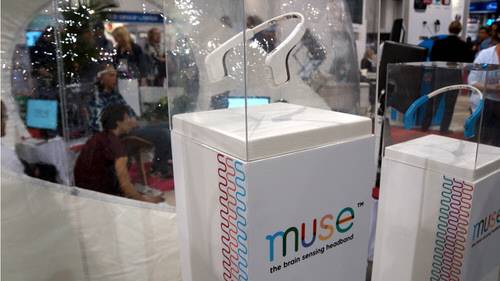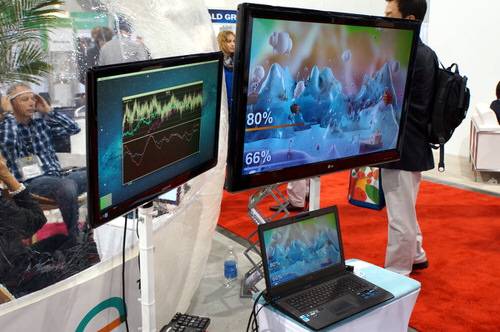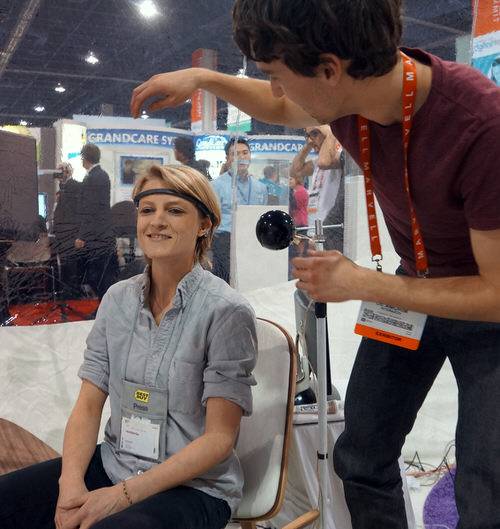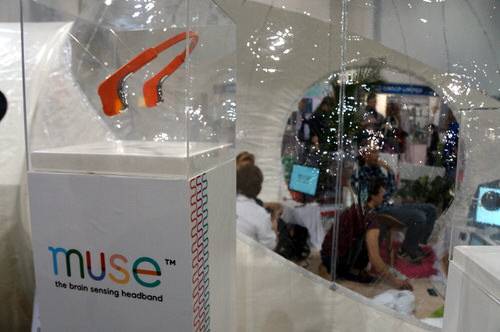
While major hardware makers are busy squabbling over “4K” vs “Ultra HD”, the future is quietly creeping in around the edges. A future with implications in the real world – big ones. Really big ones. Think using crowd-sourced mind control to change the color of Niagara Falls and the CN Tower big.
Crowd-funded and completely hackable – by definition the exact opposite of gadgets that today’s bloated, out-of-touch companies crank out – projects like the Muse headband are about to crash into technology as we know it with meteoric force.
Meet The Muse – And Your Brain Waves
Most people laud the Muse, crafted by InteraXon, as a “mind-controlled” game. But that sells it short – and then some. The device is a stylish, sturdy headband that measures the patterns of electrical activity in the brain – electrical signals are divided into “bands” based on their frequency.
“This Muse headband has four clinical-grade EEG sensors,” says Michael Apollo, InteraXon’s Director of Applied Mind Science. “What they do is measure the electrical signal and the signature of your brain. With that we know that through interpreting those signals, we can determine certain states that you’re in. We can determine when you’re in a focused, attentive state – or when you’re not. Or when you’re in an actively engaged mind, for example analyzing or maybe overanalyzing… and also looking at it at your level of relaxation too.”

The Muse measures two of the better-understood frequency tiers: alpha waves (8–12 Hz), associated with relaxation and restfulness, and beta waves (12–30 Hz), which correlate with alert or attentive mental states. “This sensor [monitors] the pre-frontal cortex and your occipital region,” says Apollo. According to InteraXon, “brains of people in relaxed states create gentle, slow-moving alpha waves, while those engaged in intense concentration generate quick, jagged beta waves.”
The Muse and devices like it might seem like they’ve traveled here from the future, but EEG has actually been around as a scientific tool for studying brain activity in humans and animals for almost 100 years. Though simple, it remains clinically relevant for diagnosis of conditions like epilepsy and sleep disorders. But InteraXon wants to empower people to take the reins of these electrical peaks and troughs. In doing so, they can gently steer their brains through these quantifiable mental states, which for most are solely a subjective, qualitative experience – a feeling we have about ourselves.
Mind-On With Mind Control
I happened across InteraXon’s booth when its inflated dome full of blissed-out looking show-goers caught my eye. A few minutes into chatting up Apollo, it was evident that the Muse is anything but pseudoscience. The Muse, available widely for consumers in mid-2013 for $175, is the marriage of electrical sensors in a wearable package with some clever data visualizations – the “game” – cooked up by InteraXon’s excitable interdisciplinary team. The games and exercises will be packaged into the Muse’s companion app, which was responsive and fun, in my time with the prototype. The app will track all of the data the Muse collects and beam it to the cloud, making these patterns trackable over time.

The Muse booth was never short on fascinated onlookers, and I was happy to get my chance. Once inside, I was rigged up with a Muse headband, which wrapped comfortably around my forehead and tucked behind my ears. It required a bit of fidgeting, the Muse didn’t like my hair getting in the way of its conductance or my freakishly small ears, but then we were off and running. Seated in a low-slung chair, I was handed an iPhone running the headset’s companion app and instructed to watch the TV screen in front of me.
Moving The Heavens And The Earth
In the first exercise, a sun and a moon appeared on opposite sides of the screen. My job was to merge them. And with no controller to speak of, that meant getting my brain to cooperate – easier said than done. The faster I could concentrate and arrive at an attentive, beta wave-rich state, the faster the sun and moon would overlap. I tried a few quick tricks to rein in my thoughts with little luck, like repeating a line from a poem I’d just read in my head over and over. The sun and moon didn’t budge, so I started counting every time one of the animated wavy lines between the two orbs hit a precise spot on the screen. The heavens moved, literally – seconds later, the sun and moon had overlapped into a virtual eclipse.
In another game, my brainwaves powered an auditory feedback system. When I was chilled out, the beat slowed to a pleasant, peaceful set of sounds. If I let my attention wander – to the cameraman pointing his lens at me from just outside the dome, for instance – a thudding drumbeat galloped into my ears. This exercise encouraged breath control, a major focus in the mindfulness and meditation practices that clearly influenced the Muse’s creators.

It’s Not A Game – It’s Data Visualization
These tasks are games, in a way, but more so they’re exercises. Rather than controlling the sun and moon or the drum beat with your thoughts, you’re actually controlling your thoughts themselves, which are in turn interpreted with the Muse’s sensory flourishes. The game is just a clever way to show you what your brain’s alpha and beta waves are up to, but it’s a fascinating representation of realtime bio-feedback – all streaming right out of your cortex over bluetooth.
The most striking thing about wearing the Muse is watching as your subjective, internal mental experience – the kind of thing you just feel in the basement of your brain – as it’s interpreted and articulated visually. Having this kind of quantified feedback makes you truly feel like the master of your own mind – and that was just from my 20 minutes with the headset on.
The Future Of The Future
So what’s the point? Well, it isn’t just to move the sun and moon together. A device like the Muse is all about personal feedback and tracking. Attention, a traditionally hard-to-pin-down construct in the neuroscience community, is also infamously tough for most of us to wrestle into submission. Our minds stray and suddenly we’ve wasted 10 minutes, eyes glazed over, clicking Like on Facebook.
The vast power of our own minds is leaking out through these kind of attentional holes that we can’t quite plug or quantify. And in the digital era, humans might be even worse at actually relaxing than we are at paying full attention to things – and we’re already pretty bad at that. Pathological multitaskers, we can hardly sit still and direct our mind toward the kind of cognitive breaks that research shows not only boost productivity, but increase crucial skills like memory retention.
Consumer-oriented, EEG-powered monitors like the Muse aren’t just about gimmicky (but cool) tricks like flying helicopters with our thoughts. Think of the applications. Therapists and mental health practitioners can affordably measure their patients’ progress on quantifiable goals. Depression and anxiety, today’s most pervasive mental disorders, are scientifically proven to yield to treatment that focuses on breaking bad cognitive habits, so-called negative “automatic thoughts.”
And consumer devices have some distinct advantages, even for the medical community. “One thing is portability,” says Erica Dixon, member of American University’s Center for Behavioral Neuroscience lab. “Something that’s really cool about these things is that if you can get a laptop, a jump drive and a headband, you can take it anywhere. Think about Doctors Without Borders – if they can even do half of what a traditional medical device could do, that’s still really amazing.”
In the workplace, imagine working in efficient bursts when you know your brain is focused rather than spreading your attention in a thin layer over a whole eight-hour shift. And that’s just the start. Later this year, when developers get their hands on the Muse’s open development kit and the little wonder headband becomes commercially available, we hope to see all sorts of cool apps and hacks spring up.
Updating Your Brain’s Firmware
According to Apollo, the idea is that a device like the Muse will actually train us to make our brains more efficient when we’re not wearing the device – by literally reprogramming the brain. “We’re using the most scientifically validated brain training protocols. We’ve run in-house studies – in the last one, within eight weeks we had people’s brains change in structure and function. They’re seeing the world through different eyes.” When the brain is the limit, the possibilities are truly endless. Welcome to the data of you – this is your quantified self.
Just put on your headband and look straight ahead.









